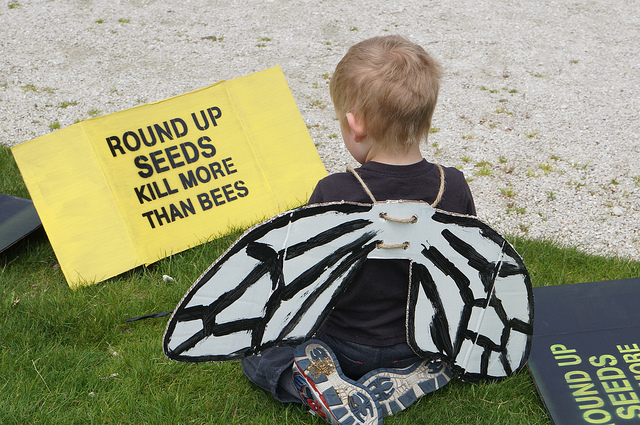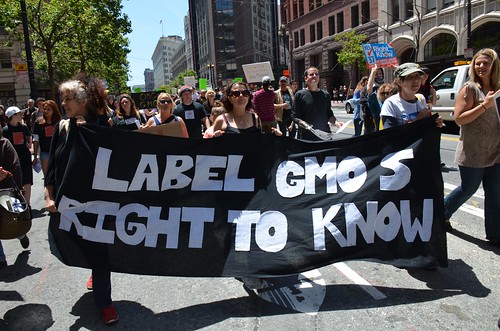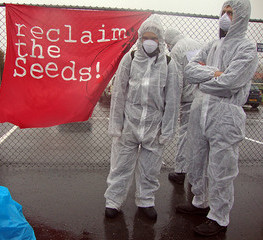Monsanto, the giant American company mainly producing genetically modified (GM) seeds, is currently fighting different battles in several parts of the world in order to maintain or secure control over the seed sector and the global food system. While in India, where it almost entirely controls the seed market, Monsanto is focused on dismissing the links between growing suicide rates among cotton farmers and its seeds, in Europe, the company wants to silence the growing numbers of protesters by promoting its products in a more subversive way. Finally, in the United States, the company has already won an enormous victory: it recently obtained legal immunity, allowing it a new type of control which entirely overlooks even the most basic concerns for human health and the environment. Since the US is the world’s largest agricultural exporter, the repercussions of the recent law will be global.
Indian farmer suicides
Between 1995 and 2011, an estimated 300,000 Indian farmers have committed suicide, many of them as a result of being indirectly forced to plant Monsanto’s Bacillus thuringiensis (Bt) cotton. In 2008, the Indian Ministry of Agriculture confirmed that it is facing a profound humanitarian crisis, with more than 1,000 farmers killing themselves each month. Ironically, most of the Indian farmers commit suicide precisely by swallowing insecticides – the expensive products they were promised they would not have to use once they started planting GM crops.
Monsanto officials and experts supporting GM food claim that the suicides are actually caused by rural poverty, alcoholism and drought, not by the company’s products. However, in January 2012, an internal advisory by the agricultural ministry of India directly linked the introduction of Bt cotton to farmers suicides by saying: “Cotton farmers are in a deep crisis since shifting to Bt cotton. The spate of farmer suicides in 2011-12 has been particularly severe among Bt cotton farmers.”
At this moment, Monsanto controls 95 percent of the Indian cotton seed market and it promotes itself as aiming to improve farmers’ lives. The company entered the Indian seed sector in 1988, after the approval of the Seed Policy imposed by the World Bank, which required the Government of India to deregulate the seed sector. Monsanto rapidly adopted a series of measures aiming to guarantee it supremacy on the Indian market. It built seed monopolies, destroyed alternatives and created monocultures of Bt cotton – as opposed to indigenous cotton varieties, which could be intercropped with food crops (intercropping, which means growing two or more crops in proximity in other, allows farmers to maximize the yield of a given piece of land). The Indian government supported the American companies’ efforts by banning traditional varieties from many governmental seed banks, all in exchange for financial assistance from the International Monetary Fund.
In India, as in many other parts of the world, GM seeds were presented as “magic seeds” which would not only yield more crops, but also be free from insects and parasites. They proved to be far from that. The GM seeds were not only often attacked and destroyed by bollworms, another type of parasite, but also required double the amount of water compared to conventional seeds. When rain failed to arrive, these seeds simply died, leaving the farmers crippled with debt and forcing them to borrow from local money-lenders yet again, in order to purchase new GM seeds at their exorbitant prices. $15 would buy Indian farmers 1,000 grams of traditional seeds, but only 100 grams of GM seeds.
In the past, when crops failed, farmers could save seeds and use them the following year. This is not possible with GM seeds, because they contain what has been dubbed the “terminator technology”. Via these techniques, seeds have been modified so as to be sterile and unable to produce viable offspring seeds of their own, or alternatively to produce viable seeds, but with specific genes switched off.
The farmers’ suicides have devastating consequences for the families left behind, who are left to pay off immense debts. Sometimes, they are forced off their lands, remaining homeless and penniless. Children are often forced to drop out of schools, because mothers can no longer afford to pay their fees.
Author and environmental activist Vandana Shiva deplores Monsanto’s seed control, stressing that: “When a corporation controls seed, it controls life. Including the life of our farmers.”
A victory for anti-GM opponents in Europe?
Monsanto is leading a different kind of battle in Europe. In May 2013, German news source TAZ proudly proclaimed in an article entitled “Victory for anti-GMO Movement: Monsanto Gives up Europe” that the American company would stop marketing its products in Europe and that its opponents had thus won a decisive battle against the company. The news made headlines in other highly-reputed and read publications, such as the Deutsche Welle and the Daily Mail.
The article was a blatant misinterpretation of the information obtained in TAZ’s interview with the official German Monsanto representative, who had clearly told the news agency that Monsanto will “sell the GM seeds only where they enjoy broad farmer support, broad political support and a functioning regulatory system. As far as we’re convinced this only applies to a few countries in Europe today, primarily Spain and Portugal.” Moreover, Monsanto Germany later released an official press release clearly denying that Monsanto intends to stop marketing GM seeds in Germany and the EU, as opposed to media claims. Monsanto is in fact currently focused on expanding its market control in Eastern Europe.
Finally, on its blog, Monsanto featured an article in which it emphasized that, in Europe, the company will continue to sell biotech seeds where they enjoy broad farmer support. The entry furthermore stated that it expects European countries will “make up their mind in their own time” about using Monsanto products. It also mentions that one of its corn species, which is resistant to the European corn borer insect, is already cultivated in Europe.
Some experts, such as William Engdahl, have interpreted the media hubbub about Monsanto’s defeat in Europe as a “carefully orchestrated Monsanto PR deception campaign.” Engdahl argues that the article in TAZ appeared only a week after March against Monsanto, a worldwide protest against Monsanto with demonstrations in more than 400 cities in some 52 countries around the world. The campaign was not organized by anti-GM organizations, but by concerned activists via Facebook, which suggests that the grassroots anti-Monsanto protest might spread, rendering it difficult for Monsanto to disseminate GM products around the world. By seemingly allowing anti-GM protesters a significant victory, the Monsanto PR campaign might aim to dissipate their momentum, while continuing subversively to expand their market.
The U.S. Monsanto Protection Act
While in Europe it may be struggling to gain support, Monsanto has recently won a tremendous political victory in the United States. In March 2013, President Barack Obama, who during his 2008 presidential campaign promised to fight for labeling GM-food, signed into law H.R. 933, a short-term spending bill which contains the highly-controversial Monsanto Protection Act, as it known by its opponents. The Act was proposed and written by Roy Blunt, a Republican from Missouri, who, according to an article published in the New York Daily News, “worked with Monsanto to craft the language in the bill.” Blunt is also a major recipient of Monsanto campaign finance. Some analysts claim that many of the members of Congress who voted on the spending bill were apparently unaware that it included the so-called Monsanto Protection Act.
Prior to the Act, groups managed to legally challenge and stop U.S. Department of Agriculture (USDA) decisions to allow biotech companies to plant GM crops. However, the new act provides the company legal immunity, as it “requires USDA to ignore court order and allow the planting of new genetically engineered crops while the agency conducts further review, after which time it’s likely too late to undo any harm.”
This means that American consumers could soon be buying and eating extremely dangerous products with detrimental, but fully unknown consequences for their health, without the possibility to demand an end to this situation. It might also mean facing “catastrophic damage to the environment, by allowing laboratory-produced organisms to be planted into the earth without oversight.”
While the signing of the Monsanto Protection Act into law has caused uproar among the general American public and concerned groups, the bill’s provisions will remain in effect at least until the end of the fiscal year on September 30, 2013. Even if it the Act would be subsequently withdrawn, the current time frame allows Monsanto plenty of time to plant and sell potentially harmful crops not only in the U.S., but worldwide as well, for instance in many countries on the African and Asian continents, given that the North American country is the biggest agricultural exporters in the world.
Conclusions: Monsanto’s worldwide battle
As seen in the examples presented above, Monsanto is waging different battles in India, Europe and the US, with a goal which is ultimately identical: to gain control over the seed market and food system. The American company does not shy away from subversive techniques such as media propaganda or using its political influence. Unless a strong unified and global grassroots movement starts fighting back constantly and ardently, the company might soon become unstoppable, truly the “Life Lord” of the planet, playing with our lives and our health as it wishes.
This is a non-profit explanation














Pingback: Si un niño de 11 años puede cargarse a Monsanto en menos de 5 minutos al menos deberías verlo | United Explanations